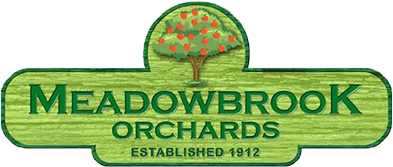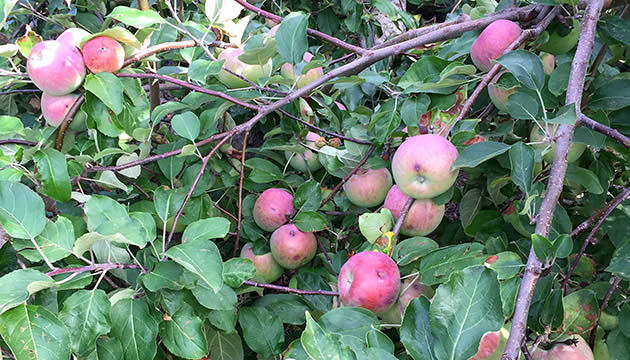Many people don’t realize how extensive the life of an apple really is. The buds of this year’s apples began to form last fall. Apples travel a long, difficult path to get to your home.
So why apples? Apples are a great source of both soluble and insoluble fiber. Soluble fiber, such as pectin, helps prevent cholesterol buildup. The insoluble fiber in apples provides bulk in the intestinal tract, which helps hold water to cleanse and move food quickly through the digestive system.
Click each link below to learn about each stage in the life of our apples.
The buds for the coming year appear on the tree in late fall, but lay dormant during the winter months until the warmer weather of spring arrives. We prune each of our 8,000 trees every other year to keep them trained to the way we want them to grow.As the temperatures get warmer, the buds begin to develop.
As the April weather approaches, the dormant buds start to become alive. The first stage of their development is silver tip. The bud scales begin to separate and they show a light grey tissue.The silver tip gives way to a green tip, followed by the leaves of the bud, which are there to protect the fruit bud. As the buds continue to mature, the leaves burst and the buds are pushed out into a tight cluster of four to six stems, soon to be flowers. During the beginning part of May, the buds blossom into a beautiful pinkish white flower.
By this point, we’ve already brought in bees to help pollinate all those blossoms. On our farm, we bring in 72 hives, each containing an average of 80,000 bees. That’s about 5,760,000 bees buzzing around, collecting pollen!
Once the bees have done their pollinating, about 75 percent of the petals of the blossoms fall.Five to ten days later, it’s evident which blossoms have at least temporarily set fruit. This stage shows the initial beginning of the actual fruit. A week or two later, some of the initial fruit set will drop, allowing the stronger fruit to grow.
During the month of June, there will be a second drop of fruit, called, not very imaginatively, the “June drop.”
During the summer months, the apples grow from the fruit set stage (about 1/2 inch) to their harvest size, which varies, depending on variety. This is the time when the apples are susceptible to a host of different dangers.Apple scab infection is a major concern for the grower. It’s caused by a virus called Venturia inaequalis. It will mainly occur when rain splashes the virus from leaf to leaf or leaf to fruit. The fruit will show black scab marks, but the inside of the apple isn’t harmed. It isn’t as attractive as it should be, therefore not acceptable to be sold.
Another danger for the apples is an insect called plum curcullio. The curcullio is a beetle that wounds the skin of an apple with a half-moon shaped scab. The apples are most susceptible soon after the petals fall. They eat a hole through the skin and feed on the pulp of the apple. it is one of the most difficult pests to manage. In the past, whole orchards had to be sprayed to keep curcullio out. Thanks to research by the late Ronald Prokopy from the University of Massachusetts, growers now only spray the border of the orchard, which greatly reduces the amount of chemicals needed to keep this pest away.
There are many other pests and dangers to the apples as they grow to maturity. Any time the threat of thunderstorms looms, the threat of hail comes with it. If the storms bring hail, it can damage the entire crop.
Provided the apples make it through the spring, summer and into the fall without damage, harvest time varies from August through October. This is the time when the orchard is bustling with activity. People are out picking fruit all day, every day. Apples have a limited amount of time that they can be picked. Too soon and the apples have a green, sour flesh; too late and they have a soft mealy flesh.The apples are carefully harvested into bins out in the orchard. The bins are then collected and brought to the main building, where they’re prepared to go into storage. We take great pride in the handling of the apples, because if they’re bounced around at all, they can be bruised and damaged, which makes them not saleable.
Damaged fruit will be used for cider or sent through our peeling machine and used for baking.
As the apples are picked, they’re placed into bins which are picked up by the tractor and brought into the packing and storage house. Some are packed right away, while others are prepared for storage. The bins are stacked up into air-tight rooms that are filled and sealed as quickly as possible.The apples are cooled to 38 degrees and the room is sealed off. We pump liquid nitrogen into the room to bring the oxygen level down to around 4%. This process puts the apples to sleep until the seal is broken and the oxygen is brought back up to normal. This process is called “controlled atmosphere storage” or CA.
Once the seal is broken, all of the apples are packed and shipped out to grocery stores, produce stands and you.

